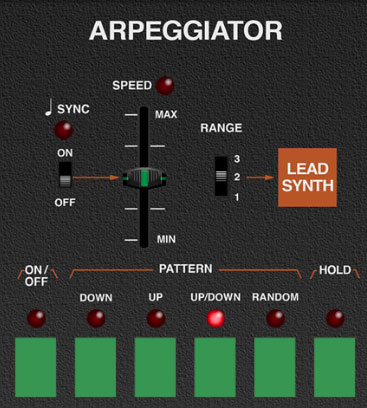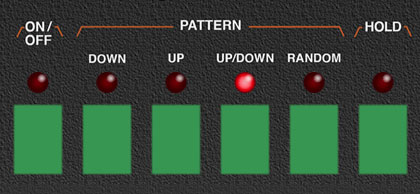
An arpeggiator is a step sequencer that individually plays each note of a chord in an ascending or descending pattern across one or more octaves. The original ARP Quadra arpeggiator was misleadingly labeled "sequencer" and was a pretty basic affair. We've expanded it with additional modes and functionally.
The Arpeggiator only affects the Lead Synthesizer (hence the arrow and big orange box to remind you).
Sync- Engaging the Sync switch locks arpeggio timing to master tempo. When engaged, the Speed slider snaps to note values ranging from 1/64th note triplet to 8 beats. Sync mode locks to the tempo in the top toolbar when using the Quadra standalone version or the current project tempo when the plug-in version is used in a DAW. Arpeggiator sync is especially useful when combined with the Echo section Sync switch - try setting the Arpeggiator rate to 1/16, and the Echo Time to 1/8 Dotted.
Speed- Sets the rate of arpeggiator play. The LED flashes at the current rate.
Range- Selects how many octaves the pattern will play before repeating.
Buttons

On/Off- Enables and disables the arpeggiator.
Pattern- Selects the order in which the notes of the chord will be played.
Down- Plays notes in order from highest to lowest.
Up- Plays notes in order from lowest to highest.
Up/Down- Plays notes from lowest to highest then back to lowest again (the highest and lowest note will be played twice in a row).
Random- Randomly cycles through notes.
Hold- When engaged, arpeggios continue to run without having to continuously hold down keys. This allows you to play a series of chords without the arpeggiator stopping as keys are released. Be aware that it will not stop until you disengage the button again. Mapping to a sustain pedal or button on a MIDI controller can be useful for conveniently toggling Hold on and off.